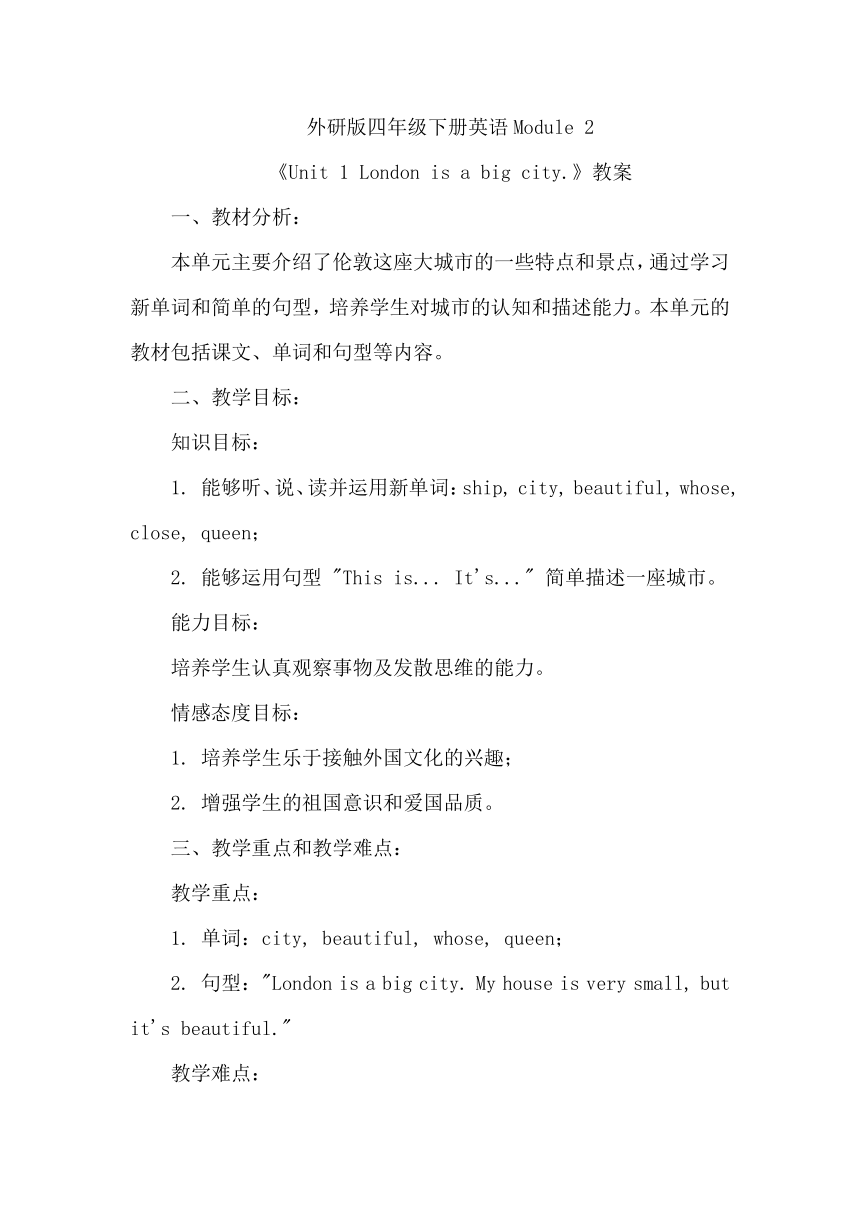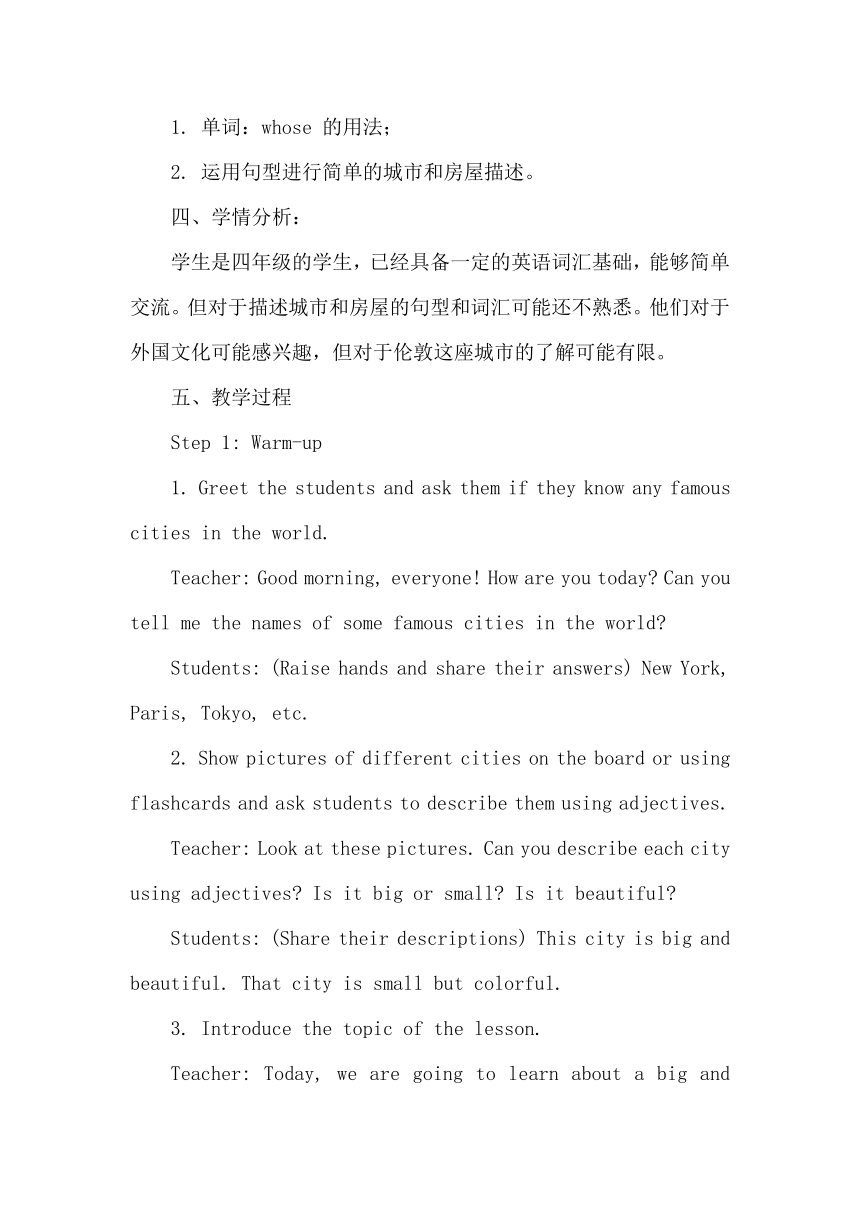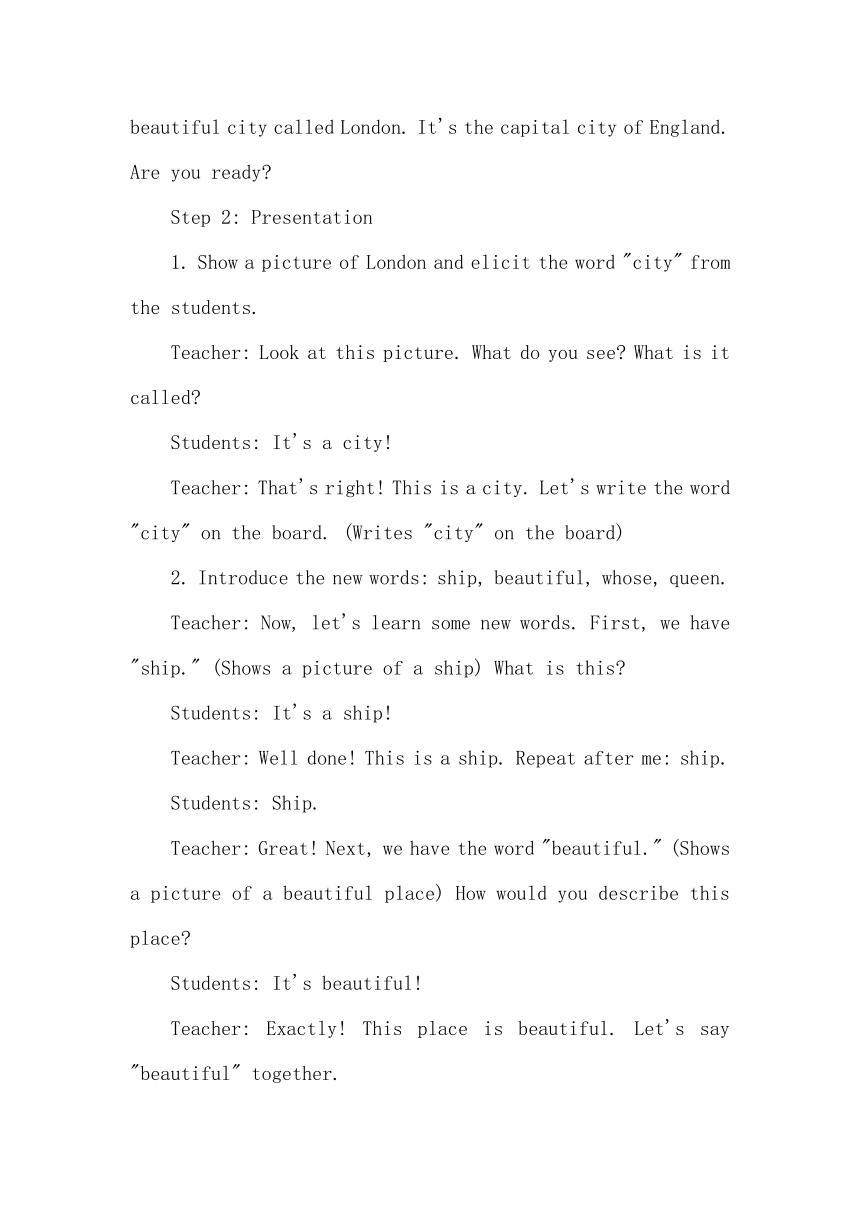Module 2 Unit 1 London is a big city. 教案(含反思)
文档属性
| 名称 | Module 2 Unit 1 London is a big city. 教案(含反思) |  | |
| 格式 | docx | ||
| 文件大小 | 14.1KB | ||
| 资源类型 | 教案 | ||
| 版本资源 | 外研版(三年级起点) | ||
| 科目 | 英语 | ||
| 更新时间 | 2024-02-17 10:16:42 | ||
图片预览



文档简介
外研版四年级下册英语Module 2
《Unit 1 London is a big city.》教案
一、教材分析:
本单元主要介绍了伦敦这座大城市的一些特点和景点,通过学习新单词和简单的句型,培养学生对城市的认知和描述能力。本单元的教材包括课文、单词和句型等内容。
二、教学目标:
知识目标:
1. 能够听、说、读并运用新单词:ship, city, beautiful, whose, close, queen;
2. 能够运用句型 "This is... It's..." 简单描述一座城市。
能力目标:
培养学生认真观察事物及发散思维的能力。
情感态度目标:
1. 培养学生乐于接触外国文化的兴趣;
2. 增强学生的祖国意识和爱国品质。
三、教学重点和教学难点:
教学重点:
1. 单词:city, beautiful, whose, queen;
2. 句型:"London is a big city. My house is very small, but it's beautiful."
教学难点:
1. 单词:whose 的用法;
2. 运用句型进行简单的城市和房屋描述。
四、学情分析:
学生是四年级的学生,已经具备一定的英语词汇基础,能够简单交流。但对于描述城市和房屋的句型和词汇可能还不熟悉。他们对于外国文化可能感兴趣,但对于伦敦这座城市的了解可能有限。
五、教学过程
Step 1: Warm-up
1. Greet the students and ask them if they know any famous cities in the world.
Teacher: Good morning, everyone! How are you today Can you tell me the names of some famous cities in the world
Students: (Raise hands and share their answers) New York, Paris, Tokyo, etc.
2. Show pictures of different cities on the board or using flashcards and ask students to describe them using adjectives.
Teacher: Look at these pictures. Can you describe each city using adjectives Is it big or small Is it beautiful
Students: (Share their descriptions) This city is big and beautiful. That city is small but colorful.
3. Introduce the topic of the lesson.
Teacher: Today, we are going to learn about a big and beautiful city called London. It's the capital city of England. Are you ready
Step 2: Presentation
1. Show a picture of London and elicit the word "city" from the students.
Teacher: Look at this picture. What do you see What is it called
Students: It's a city!
Teacher: That's right! This is a city. Let's write the word "city" on the board. (Writes "city" on the board)
2. Introduce the new words: ship, beautiful, whose, queen.
Teacher: Now, let's learn some new words. First, we have "ship." (Shows a picture of a ship) What is this
Students: It's a ship!
Teacher: Well done! This is a ship. Repeat after me: ship.
Students: Ship.
Teacher: Great! Next, we have the word "beautiful." (Shows a picture of a beautiful place) How would you describe this place
Students: It's beautiful!
Teacher: Exactly! This place is beautiful. Let's say "beautiful" together.
Students: Beautiful.
Teacher: Excellent! Now, we have the word "whose." (Shows a picture of a family) Do you know whose family this is
Students: No.
Teacher: "Whose" is used to ask about possession or ownership. For example, we can ask, "Whose pencil is this " Can you say "whose"
Students: Whose.
Teacher: Perfect! Lastly, we have the word "queen." (Shows a picture of a queen) Who is she
Students: She's a queen!
Teacher: Yes, she is a queen. Let's say "queen."
Students: Queen.
3. Model the sentence "London is a big city" and have the students repeat after you.
Teacher: Now, let's learn a sentence about London. Listen and repeat after me: "London is a big city."
Students: (Repeat) London is a big city.
4. Model the sentence "My house is very small, but it's beautiful" and have the students repeat after you.
Teacher: Now, let's learn another sentence. Listen and repeat: "My house is very small, but it's beautiful."
Students: (Repeat) My house is very small, but it's beautiful.
5. Practice pronouncing the new words and sentences together as a class.
Teacher: Let's practice saying the new words and sentences together. Repeat after me: ship, beautiful, whose, queen, London is a big city, My house is very small, but it's beautiful.
Step 3: Practice
1. Divide the class into pairs or small groups.
2. Give each group a picture of a city or a landmark and have them describe it using the new words and sentences.
Teacher: Now, I will give each group a picture of a city or a landmark. Work together and describe it using the new words and sentences we have learned. For example, "This is a beautiful city. It has a big ship and a queen."
3. Monitor the groups and provide assistance as needed.
4. Ask some groups to share their descriptions with the whole class.
Teacher: Group A, can you share your description with the class
Step 4: Consolidation
1. Review the new words and sentences with the whole class. Have students repeat after you.
Teacher: Let's review the new words and sentences. Repeat after me: ship, beautiful, whose, queen, London is a big city, My house is very small, but it's beautiful.
2. Show pictures of different cities and landmarks again. Ask students to describe them using the new words and sentences they have learned.
Teacher: Look at these pictures again. Describe each city or landmark using the new words andsentences we have learned. For example, "This city is beautiful. It has a big ship and a queen." Let's take turns and share our descriptions.
Step 5: Wrap-up
1. Recap the lesson by asking students to share one interesting thing they have learned about London or any other city.
Teacher: Before we finish, can you share one interesting thing you have learned about London or any other city we talked about today
Students: (Share their responses) I learned that London has a famous clock called Big Ben.
2. Give positive feedback and praise to students for their effort and participation.
Teacher: Great job, everyone! I'm impressed with your descriptions and active participation today. You all did an excellent job learning about cities and using the new words and sentences. Keep up the good work!
六、板书设计:
City Beautiful Whose Queen
London is a big city.
My house is very small, but it's beautiful.
七、教学反思:
本节课通过引导学生观察城市和发散思维,培养了他们对城市的认知和表达能力。学生在小组活动中有机会运用新学的单词和句型进行描述,通过实际操作加深了对知识的理解和记忆。在教学过程中,学生的参与度较高,积极回答问题并展示了他们的创造力和表达能力。教师在活动中及时给予肯定和鼓励,激发了学生学习英语的兴趣。在以后的教学中,可以进一步拓展学生对其他城市和国家的了解,培养他们对多元文化的尊重和包容性。同时,也可以加强对句型结构和语法的讲解和练习,帮助学生更好地运用所学的知识。整体而言,本节课达到了预期的教学目标,并且学生在学习过程中获得了积极的学习体验。
《Unit 1 London is a big city.》教案
一、教材分析:
本单元主要介绍了伦敦这座大城市的一些特点和景点,通过学习新单词和简单的句型,培养学生对城市的认知和描述能力。本单元的教材包括课文、单词和句型等内容。
二、教学目标:
知识目标:
1. 能够听、说、读并运用新单词:ship, city, beautiful, whose, close, queen;
2. 能够运用句型 "This is... It's..." 简单描述一座城市。
能力目标:
培养学生认真观察事物及发散思维的能力。
情感态度目标:
1. 培养学生乐于接触外国文化的兴趣;
2. 增强学生的祖国意识和爱国品质。
三、教学重点和教学难点:
教学重点:
1. 单词:city, beautiful, whose, queen;
2. 句型:"London is a big city. My house is very small, but it's beautiful."
教学难点:
1. 单词:whose 的用法;
2. 运用句型进行简单的城市和房屋描述。
四、学情分析:
学生是四年级的学生,已经具备一定的英语词汇基础,能够简单交流。但对于描述城市和房屋的句型和词汇可能还不熟悉。他们对于外国文化可能感兴趣,但对于伦敦这座城市的了解可能有限。
五、教学过程
Step 1: Warm-up
1. Greet the students and ask them if they know any famous cities in the world.
Teacher: Good morning, everyone! How are you today Can you tell me the names of some famous cities in the world
Students: (Raise hands and share their answers) New York, Paris, Tokyo, etc.
2. Show pictures of different cities on the board or using flashcards and ask students to describe them using adjectives.
Teacher: Look at these pictures. Can you describe each city using adjectives Is it big or small Is it beautiful
Students: (Share their descriptions) This city is big and beautiful. That city is small but colorful.
3. Introduce the topic of the lesson.
Teacher: Today, we are going to learn about a big and beautiful city called London. It's the capital city of England. Are you ready
Step 2: Presentation
1. Show a picture of London and elicit the word "city" from the students.
Teacher: Look at this picture. What do you see What is it called
Students: It's a city!
Teacher: That's right! This is a city. Let's write the word "city" on the board. (Writes "city" on the board)
2. Introduce the new words: ship, beautiful, whose, queen.
Teacher: Now, let's learn some new words. First, we have "ship." (Shows a picture of a ship) What is this
Students: It's a ship!
Teacher: Well done! This is a ship. Repeat after me: ship.
Students: Ship.
Teacher: Great! Next, we have the word "beautiful." (Shows a picture of a beautiful place) How would you describe this place
Students: It's beautiful!
Teacher: Exactly! This place is beautiful. Let's say "beautiful" together.
Students: Beautiful.
Teacher: Excellent! Now, we have the word "whose." (Shows a picture of a family) Do you know whose family this is
Students: No.
Teacher: "Whose" is used to ask about possession or ownership. For example, we can ask, "Whose pencil is this " Can you say "whose"
Students: Whose.
Teacher: Perfect! Lastly, we have the word "queen." (Shows a picture of a queen) Who is she
Students: She's a queen!
Teacher: Yes, she is a queen. Let's say "queen."
Students: Queen.
3. Model the sentence "London is a big city" and have the students repeat after you.
Teacher: Now, let's learn a sentence about London. Listen and repeat after me: "London is a big city."
Students: (Repeat) London is a big city.
4. Model the sentence "My house is very small, but it's beautiful" and have the students repeat after you.
Teacher: Now, let's learn another sentence. Listen and repeat: "My house is very small, but it's beautiful."
Students: (Repeat) My house is very small, but it's beautiful.
5. Practice pronouncing the new words and sentences together as a class.
Teacher: Let's practice saying the new words and sentences together. Repeat after me: ship, beautiful, whose, queen, London is a big city, My house is very small, but it's beautiful.
Step 3: Practice
1. Divide the class into pairs or small groups.
2. Give each group a picture of a city or a landmark and have them describe it using the new words and sentences.
Teacher: Now, I will give each group a picture of a city or a landmark. Work together and describe it using the new words and sentences we have learned. For example, "This is a beautiful city. It has a big ship and a queen."
3. Monitor the groups and provide assistance as needed.
4. Ask some groups to share their descriptions with the whole class.
Teacher: Group A, can you share your description with the class
Step 4: Consolidation
1. Review the new words and sentences with the whole class. Have students repeat after you.
Teacher: Let's review the new words and sentences. Repeat after me: ship, beautiful, whose, queen, London is a big city, My house is very small, but it's beautiful.
2. Show pictures of different cities and landmarks again. Ask students to describe them using the new words and sentences they have learned.
Teacher: Look at these pictures again. Describe each city or landmark using the new words andsentences we have learned. For example, "This city is beautiful. It has a big ship and a queen." Let's take turns and share our descriptions.
Step 5: Wrap-up
1. Recap the lesson by asking students to share one interesting thing they have learned about London or any other city.
Teacher: Before we finish, can you share one interesting thing you have learned about London or any other city we talked about today
Students: (Share their responses) I learned that London has a famous clock called Big Ben.
2. Give positive feedback and praise to students for their effort and participation.
Teacher: Great job, everyone! I'm impressed with your descriptions and active participation today. You all did an excellent job learning about cities and using the new words and sentences. Keep up the good work!
六、板书设计:
City Beautiful Whose Queen
London is a big city.
My house is very small, but it's beautiful.
七、教学反思:
本节课通过引导学生观察城市和发散思维,培养了他们对城市的认知和表达能力。学生在小组活动中有机会运用新学的单词和句型进行描述,通过实际操作加深了对知识的理解和记忆。在教学过程中,学生的参与度较高,积极回答问题并展示了他们的创造力和表达能力。教师在活动中及时给予肯定和鼓励,激发了学生学习英语的兴趣。在以后的教学中,可以进一步拓展学生对其他城市和国家的了解,培养他们对多元文化的尊重和包容性。同时,也可以加强对句型结构和语法的讲解和练习,帮助学生更好地运用所学的知识。整体而言,本节课达到了预期的教学目标,并且学生在学习过程中获得了积极的学习体验。
同课章节目录
- Module 1
- Unit 1 She's a nice teache
- Unit 2 He's cool.
- Module 2
- Unit 1 London is a big city.
- Unit 2 It's very old.
- Module 3
- Unit 1 Robots will do everything.
- Unit 2 On Monday I'll go swimming.
- Module 4
- Unit 1 Will you take your kite?
- Unit 2 Will it be hot in Haikou?
- Module 5
- Unit 1 I was two then.
- Unit 2 They were young.
- Module 6
- Unit 1 Were you at home yesterday?
- Unit 2 Was it a big city then ?
- Module 7
- Unit 1 I helped Mum.
- Unit 2 Grandma cooked fish.
- Module 8
- Unit 1 They sang beautifully.
- Unit 2 I took some pictures.
- Module 9
- Unit 1 Did he live in New York ?
- Unit 2 Did you have a nice holiday?
- Review Module
- Unit 1
- Unit 2
- Module 10
- Unit 1 Did you fall off your bike?
- Unit 2 Sam had lots of chocolate.
